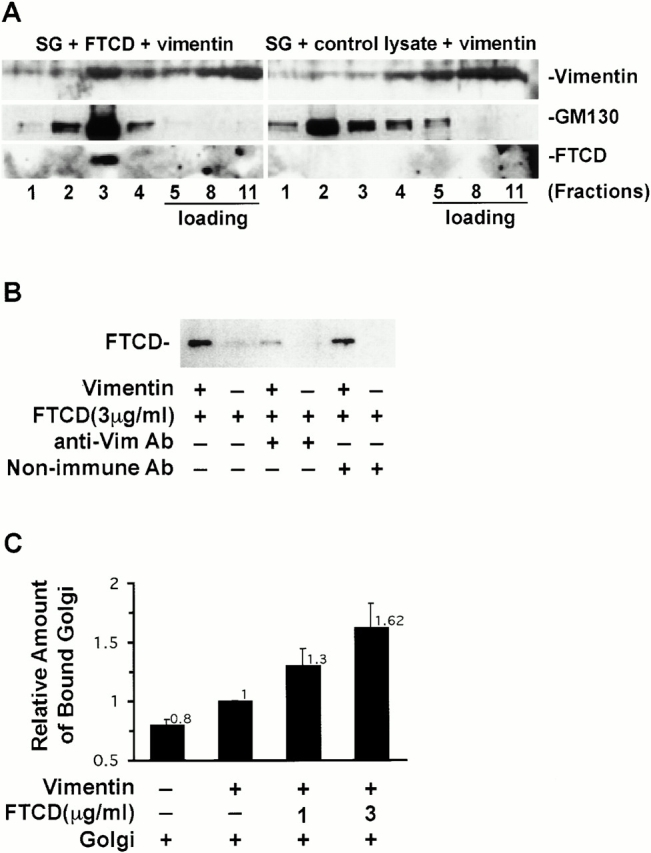Figure 9.

FTCD promotes binding of Golgi elements to vimentin. (A) Isolated Golgi elements were incubated either with bacterially expressed and purified FTCD (SG + FTCD + vimentin) or with control bacterial lysate (SG + control lysate + vimentin). The mixtures were loaded at the bottom of a sucrose density gradient and subjected to equilibrium centrifugation to separate soluble proteins from the Golgi membranes. Membrane-containing fractions were combined and supplemented with recombinant vimentin. The mixtures were loaded at the bottom of a sucrose density gradient and subjected to another equilibrium centrifugation. An equivalent amount of each fraction was processed by SDS-PAGE, transferred to NC, and immunoblotted with antivimentin, anti-GM130, and anti-FTCD antibodies. A proportion of vimentin binds to Golgi elements in the absence of exogenously added FTCD (SG + control lysate + vimentin), but vimentin binding is significantly increased by preincubating the Golgi elements with FTCD (SG + FTCD + vimentin). (B) Poly-l-lysine–coated microtiter wells containing adsorbed vimentin (+) or lacking vimentin (−) received bacterially expressed and purified FTCD, a mixture of FTCD and goat antivimentin antiserum, or a mixture of FTCD and goat nonimmune antiserum. After washing, bound material from triplicate wells was recovered with SDS-PAGE sample buffer and pooled. The pooled material was processed by SDS-PAGE, transferred to NC, and immunoblotted with anti-FTCD antibodies. Vimentin mediates FTCD binding to the wells since FTCD is recovered in wells containing adsorbed vimentin but not in wells lacking vimentin, and FTCD binding is inhibited by antivimentin antibodies. (C) Poly-l-lysine–coated microtiter wells lacking vimentin or containing adsorbed vimentin received buffer, or increasing amounts of bacterially expressed and purified FTCD. Each experimental group contained four wells. After washing to remove unbound FTCD, isolated Golgi elements were added to the wells. After washing to remove unbound Golgi elements, antigiantin antibodies and HRP-conjugated secondary antibodies were added sequentially, followed by an HRP-based colorimetric assay. Background value without Golgi addition has been subtracted from each group. The amount of Golgi binding to vimentin-containing wells without FTCD was set as 1. Each value is an average of three independent experiments, and bars indicate SD. Golgi elements preferentially bind to wells containing adsorbed vimentin, and this association is increased by FTCD in a dose-dependent manner.
